|
|
Canku Ota |
|
|
(Many Paths) |
||
|
An Online Newsletter Celebrating Native America |
||
|
December 28, 2002 - Issue 77 |
||
|
|
||
|
Rabbit and the Moon Man |
||
|
Micmac Legend
|
||
|
|
|
At first Rabbit thought that the robber might be a cunning pine marten, until one morning he found long, narrow footprints alongside his trap line. It was, he thought, the tracks of the robber, but they looked like moonbeams. Each morning Rabbit rose earlier and earlier, but the being of the long foot was always ahead of him and always his traps were empty.
Someone or something came stealthily through the trees and then Rabbit was almost blinded by a flash of bright, white light which went straight to his trap line and shone through the snare which he had set. Quick as a lightning flash, Rabbit jerked the bowstring and tightened the noose. There was a sound of struggling and the light lurched from side to side. Rabbit knew by the tugging on his string that he had caught the robber. He fastened the bowstring to a nearby sapling, to hold the loop tight. Rabbit raced back to tell his grandmother, who was a wise old woman, what had happened. She told him that he must return at once and see who or what he had caught. Rabbit, who was very frightened, wanted to wait for daylight but his grandmother said that might be too late, so he returned to his trap line.
Then a strange, quivering voice asked why he had been snared and demanded that he be set free at once, because he was the man in the moon and he must be home before dawn came. His face had been spotted with clay and, when Rabbit went closer, the moon man saw him and threatened to kill him and all of his tribe if he were not released at once. Rabbit was so terrified that he raced back to tell his grandmother about his strange captive. She too was much afraid and told Rabbit to return and release the thief immediately. Rabbit went back, and his voice shook with fear as he told the man in the moon that he would be released if he promised never to rob the snares again. To make doubly sure, Rabbit asked him to promise that he would never return to earth, and the moon man swore that he would never do so. Rabbit could hardly see in the dazzling light, but at last he managed to gnaw through the bowstring with his teeth and the man in the moon soon disappeared in the sky, leaving a bright trail of light behind him. Rabbit had been nearly blinded by the great light and his shoulders were badly scorched. Even today, rabbits blink as though light is too strong for their eyes; their eyelids are pink, and their eyes water if they look at a bright light. Their lips quiver, telling of Rabbit's terror.
Print
and Color Your Own Pine Marten |
|
|
|
Pine Marten (Martes
americana)
|
|
Description Pine martens have long, bushy tails that are one-third of their total length. Like other species in the weasel family, they differ in size according to sex. The female is about three-fourths the size of the male. Sometimes people confuse pine martens with two other members of the weasel family, fishers (Martens pennati) and stone martens (Martens foina). Fishers live in similar habitat and have similar tracks. However, they're larger (females 20-27 inches, 4-8 pounds; males 30- 40 inches, 7-15 pounds) and darker than pine martens. Stone martens are a species native to Europe and Asia. Stone martens are 23-31 inches long (including the tail), weigh 1-4.5 pounds and are pale gray to brown with a white throat patch. Habits Pine martens live in mature, dense conifer forests. They prefer woods with northern white cedar, balsam fir, spruce and eastern hemlock, especially where trees have fallen. These forests provide prey, protection and den sites. In the past, the cutting of large areas of mature conifer forests destroyed much marten habitat. The size of a male pine marten's territory is 5-10 square miles, while a female's may range in size from 1-5 square miles. Pine martens generally cover their entire territory every 8-10 days as they hunt. Neither males nor females will tolerate another pine marten of the same sex in their territory. A male, however, will allow several females in his territory. Food Mice and other small rodents are martens' primary prey, but they also eat squirrels, hares, shrews, birds, bird eggs, amphibians, reptiles, insects, fish, crayfish, nuts, fruits and carrion. In the winter, martens will tunnel under the snow in search of mice and other small mammals. Breeding
Biology Although the female marten's eggs are fertilized by mid-summer, they don't fasten to the wall of her uterus until January or February. The fetuses then develop quickly; young are born in late March or April, nine months after fertilization. The female makes a den in a hollow tree, stump or rock crevice, lines it with leaves, moss and other vegetation and gives birth to 2- 4 kits. The male takes no part in rearing the young. The sparsely furred, newborn pine martens have their eyes closed. When the kits are five weeks old, their eyes open and the female begins to feed them meat. They're weaned at 6-7 weeks and almost full-grown when three months old. The female leaves her kits soon after they're weaned, when she's able to mate again. Young martens may move out of their home territory in late summer or early fall to establish their own territories. Distribution Today, pine martens live across Canada and Alaska and in the Sierra Nevada Mountains, the Rocky Mountains south to Colorado and the northern parts of Minnesota, Wisconsin, Michigan, New York and the northern New England states. Current
Status
|
|
|
||
|
|
||
| Canku Ota is a free Newsletter celebrating Native America, its traditions and accomplishments . We do not provide subscriber or visitor names to anyone. Some articles presented in Canku Ota may contain copyright material. We have received appropriate permissions for republishing any articles. Material appearing here is distributed without profit or monetary gain to those who have expressed an interest. This is in accordance with Title 17 U.S.C. section 107. | ||
|
Canku Ota is a copyright © 2000, 2001, 2002 of Vicki Lockard and Paul Barry. |
||
 |
 |
|
|
The "Canku Ota - A Newsletter Celebrating Native America" web site and its design is the |
||
|
Copyright © 1999, 2000, 2001, 2002 of Paul C. Barry. |
||
|
All Rights Reserved. |
||
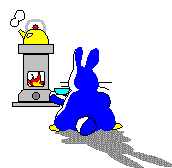 Long
ago, Rabbit was a great hunter. He lived with his grandmother in a lodge
which stood deep in the Micmac forest. It was winter and Rabbit set
traps and laid snares to catch game for food. He caught many small animals
and birds, until one day he discovered that some mysterious being was
robbing his traps. Rabbit and his grandmother became hungry. Though
he visited his traps very early each morning, he always found them empty.
Long
ago, Rabbit was a great hunter. He lived with his grandmother in a lodge
which stood deep in the Micmac forest. It was winter and Rabbit set
traps and laid snares to catch game for food. He caught many small animals
and birds, until one day he discovered that some mysterious being was
robbing his traps. Rabbit and his grandmother became hungry. Though
he visited his traps very early each morning, he always found them empty.
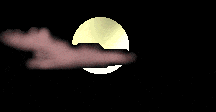 Rabbit
made a trap from a bowstring with the loop so cleverly fastened that
he felt certain that he would catch the robber when it came. He took
one end of the thong with him and hid himself behind a clump of bushes
from which he could watch his snare. It was bright moonlight while he
waited, but suddenly it became very dark as the moon disappeared. A
few stars were still shining and there were no clouds in the sky, so
Rabbit wondered what had happened to the moon.
Rabbit
made a trap from a bowstring with the loop so cleverly fastened that
he felt certain that he would catch the robber when it came. He took
one end of the thong with him and hid himself behind a clump of bushes
from which he could watch his snare. It was bright moonlight while he
waited, but suddenly it became very dark as the moon disappeared. A
few stars were still shining and there were no clouds in the sky, so
Rabbit wondered what had happened to the moon.  When
he came near his traps, Rabbit saw that the bright light was still there.
It was so bright that it hurt his eyes. He bathed them in the icy water
of a nearby brook, but still they smarted. He made big snowballs and
threw them at the light, in the hope of putting it out. As they went
close to the light, he heard them sizzle and saw them melt. Next, Rabbit
scooped up great pawfuls of soft clay from the stream and made many
big clay balls. He was a good shot and threw the balls with all of his
force at the dancing white light. He heard them strike hard and then
his prisoner shouted.
When
he came near his traps, Rabbit saw that the bright light was still there.
It was so bright that it hurt his eyes. He bathed them in the icy water
of a nearby brook, but still they smarted. He made big snowballs and
threw them at the light, in the hope of putting it out. As they went
close to the light, he heard them sizzle and saw them melt. Next, Rabbit
scooped up great pawfuls of soft clay from the stream and made many
big clay balls. He was a good shot and threw the balls with all of his
force at the dancing white light. He heard them strike hard and then
his prisoner shouted.  The
man in the moon has never returned to earth. When he lights the world,
one can still see the marks of the clay which Rabbit threw on his face.
Sometimes he disappears for a few nights, when he is trying to rub the
marks of the clay balls from his face. Then the world is dark; but when
the man in the moon appears again, one can see that he has never been
able to clean the clay marks from his shining face.
The
man in the moon has never returned to earth. When he lights the world,
one can still see the marks of the clay which Rabbit threw on his face.
Sometimes he disappears for a few nights, when he is trying to rub the
marks of the clay balls from his face. Then the world is dark; but when
the man in the moon appears again, one can see that he has never been
able to clean the clay marks from his shining face. 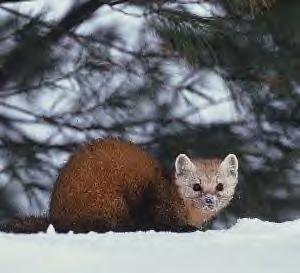 Marten
(Martes americana) are members of the family Mustelidae, which also
includes wolverines, weasels and fishers. The South Slavey word for
marten is "nohthee", in North Slavey marten are "zo",
in Dogrib they are "wha" and in Gwich'in they are "tsuk".
They are also called pine marten and American marten.
Marten
(Martes americana) are members of the family Mustelidae, which also
includes wolverines, weasels and fishers. The South Slavey word for
marten is "nohthee", in North Slavey marten are "zo",
in Dogrib they are "wha" and in Gwich'in they are "tsuk".
They are also called pine marten and American marten. 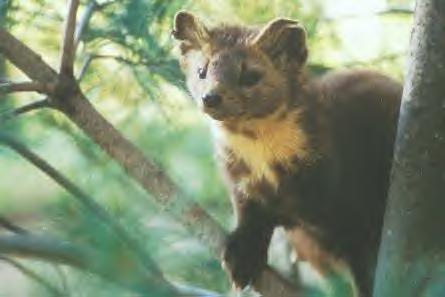 Pine
martens are omnivores, feeding on a great variety of foods. Even though
they're at home in trees, they do most of their hunting on the ground.
They have a high metabolism, thus require a lot of food for energy.
This intense need for food makes them easy to trap.
Pine
martens are omnivores, feeding on a great variety of foods. Even though
they're at home in trees, they do most of their hunting on the ground.
They have a high metabolism, thus require a lot of food for energy.
This intense need for food makes them easy to trap. 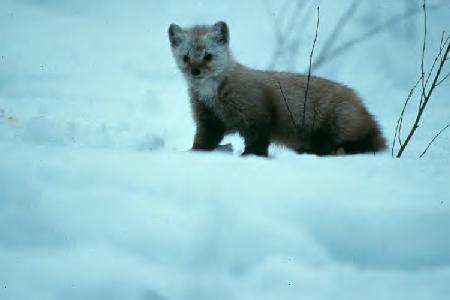 Historically,
pine martens inhabited mature conifer forests of the northern United
States north to treeline in Canada. Populations extended southward along
the Sierra Nevada Mountains in California, the Rocky Mountains to New
Mexico, the Great Lakes and the Ohio River Valley to southern Ohio.
Historically,
pine martens inhabited mature conifer forests of the northern United
States north to treeline in Canada. Populations extended southward along
the Sierra Nevada Mountains in California, the Rocky Mountains to New
Mexico, the Great Lakes and the Ohio River Valley to southern Ohio.